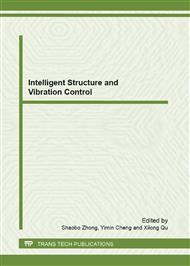[1]
J.A. Gonza'lez. Some questions on the corrosion of steel in concrete. Part 1: when, how and how much steel corrodes. Materials and Structures, Vol. 29, January-February (1996), pp.40-46.
DOI: 10.1007/bf02486005
Google Scholar
[2]
Shi Qing-xuan. Experimental study of bearing capacity of corroded reinforced concrete eccentric compressive members. Industrial Construction, Vol. 31, No. 5 (2001), pp.14-17.
Google Scholar
[3]
XU Shanhua, The models of deterioration and durability evaluation of reinforced concrete structure, Xi'anUniversity of Architecture and Technology, (2003).
Google Scholar
[4]
Fu-Xue Sun. Theoretical and Experimental Studies on Predicting the ServieeLife of Subsea Tunnel Lining Structures, [D]. TongJi University, (2006).
Google Scholar
[5]
LEI Guoqiang. Experimental research on the carrying capacity of corroded R.C. columns, [D]. Hunan University, (2007).
Google Scholar
[6]
YI Weijian. Experimental Research on the Bearing Capacity of Corroded Reinforced Concrete Columns. Journal of Hunan University (Natural Sciences), No. 3(2008), pp.6-10.
Google Scholar
[7]
Xiao-HuiWang, Fa-Yun Liang. Performance of RC columns with partial length corrosion, Nuclear Engineering and Design, No. 238 (2008), p.3194–3202.
DOI: 10.1016/j.nucengdes.2008.08.007
Google Scholar
[8]
WEI Jun, ZHANG Hua. Experimental research on the deterioration of the flexural stiffness of eccentric compressive members due to the corroded bar. Journal of Wuhan University of Technology, No. 7 (2009), pp.60-64.
Google Scholar
[9]
Xue-bin LU. Buckling property of corroded steel rebar and lts influences on reinforced conerete column seetional strength [D], TongJi University, (2007).
Google Scholar
[10]
Li, Qiang. Bearing capacity of corroded RC columns, ICIC 2010-3rd International Conference on Information and Computing. Wuxi, Jiang Su, China, (2010), pp.233-236.
DOI: 10.1109/icic.2010.243
Google Scholar
[11]
GB50010-2002. Code for Design of Concrete Structures (in Chinese), Beijing: China Architecture & Building Press, China, (2002).
Google Scholar
[12]
CECS 220, Standard for durability assessment of concrete structures (in Chinese), Beijing: China Engineering Construction Standard (CECS) Association, China Planning Press, China, (2007).
Google Scholar
[13]
Hui Yunling, Li Rong. Experimental studies on the property before and after corrosion of rebar in basic concrete members. Industrial Construction, No. 6, (1997), pp.14-18.
Google Scholar
[14]
PAN Yi, CHEN Zhaohui. Experimental studies on the property of corrosion in basic concrete members. Sichuan Building Science, No. 3, (2004), pp.71-74.
Google Scholar
[15]
Tao Feng, Wang Linke. Experimental study on the bearing capacity of existing reinforced concrete members. Industrial Construction. No. 4, (1996), pp.17-20.
Google Scholar


